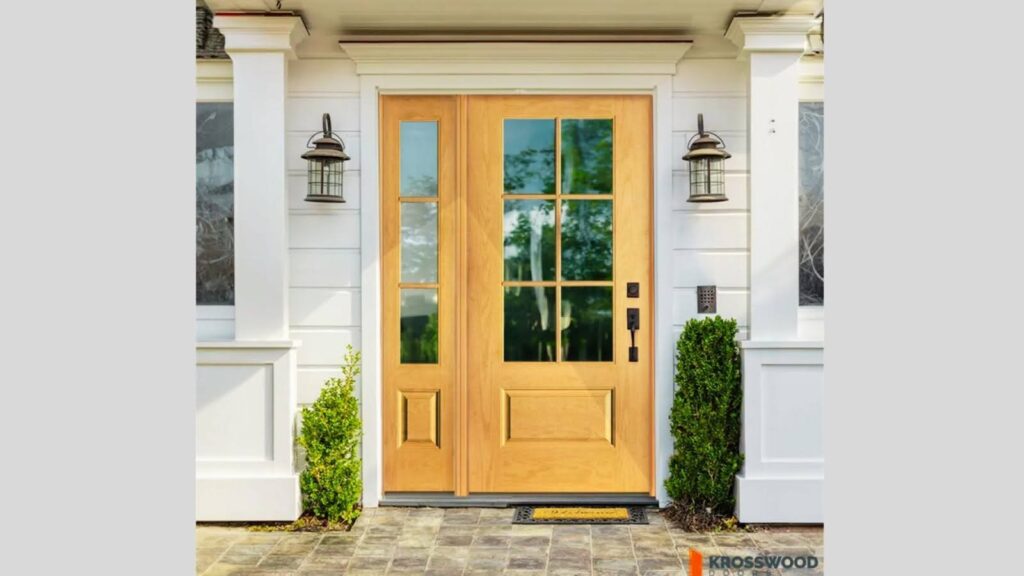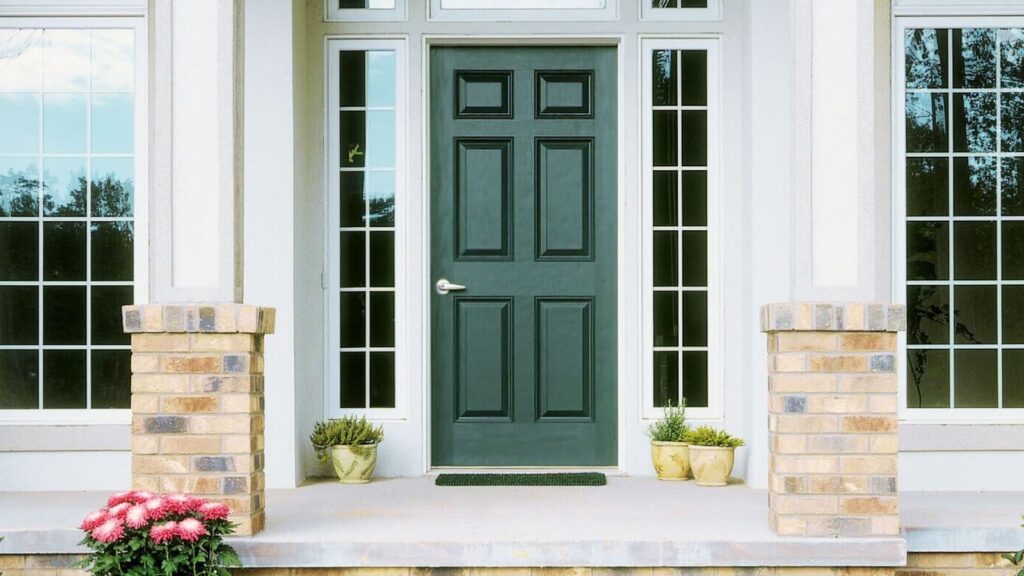Picking a new front door is a big decision. You want something that looks good, keeps your home safe, and lasts for years. That’s where the steel vs fiberglass door debate comes in.
I’ve helped dozens of homeowners make this choice, and I know how confusing it can be. This guide will break down everything you need to know.
We’ll compare costs, security, looks, and durability. You’ll learn which door fits your budget, climate, and style.
By the end, you’ll know exactly which material works best for your home. Let’s get started.
What Are Fiberglass Doors?

Fiberglass doors combine synthetic materials with foam cores to create durable, low-maintenance entry doors.
Fiberglass doors blend glass fibers with resin for strength. A foam core adds insulation. They mimic real wood grain or offer smooth finishes without rotting or warping.
Weather can’t harm them. Rain, humidity, and salt air cause no damage. Maintenance is simple, just occasional washing.
Best for coastal or humid climates. Perfect if you want a wood look without constant upkeep.
What Are Steel Doors?

Steel doors feature metal skins over insulated cores, offering strong security and affordability for homeowners.
Steel doors have a metal shell with foam inside. They’re treated to prevent rust.
Security is their strength. Steel resists break-ins and won’t crack. The cost is low, making them budget-friendly.
Best for security needs and tight budgets. Works well in moderate climates.
Appearance & Design Options
Both materials offer various styles, but they differ in how realistic they look compared to wood.
Style Variations in Fiberglass Doors

Fiberglass comes in dozens of designs. You can find smooth contemporary styles or textured wood grain patterns.
Panel configurations range from simple single panels for modern looks to six or eight panels for traditional feels. Glass inserts add character and light.
Staining is possible. The material absorbs stains like wood and you can change the color later.
Style Variations in Steel Doors

Steel doors offer fewer texture options. Most have a smooth finish. Some have stamped patterns.
Color choices are wide. Factory-painted steel comes in white, black, brown, and custom colors. The paint is durable.
Glass options like decorative windows, sidelights, and transoms add visual interest to steel surfaces.
Wood-Look Comparison: Which Looks More Real?

Fiberglass wins easily. The molded texture captures real wood details convincingly. It’s hard to tell the difference from a few feet away.
Steel can’t replicate wood grain. If you want a wood appearance, choose fiberglass. Steel looks fine with a smooth painted finish but won’t fool anyone into thinking it’s wood.
Durability & Lifespan
Understanding how each material holds up over time helps you plan for the future.
| Aspect | Steel Doors | Fiberglass Doors |
| Impact Resistance | Dents permanently when hit. Hard to fix. | Flexes and returns to shape. Resists everyday damage. |
| Weather Performance | Rusts in moisture. Fades in the sun. Struggles in extreme cold. | Excels in all climates. No warping, rotting, or rust. |
| Coastal/Salt Exposure | Corrodes quickly from salt air. | Completely unaffected by salt. |
| Expected Lifespan | 20 to 30 years with regular maintenance. | 30+ years with minimal care. |
Security Comparison
Your front door is your home’s first line of defense against intruders.
Steel provides superior kick-in resistance and won’t splinter under force. Fiberglass is strong but not as tough. Both offer good protection with proper installation and quality locks.
Frame Compatibility & Hardware Considerations
Steel accepts heavy-duty locks and deadbolts easily. The metal supports reinforced strike plates.
Fiberglass handles quality hardware well and is solid enough for standard deadbolts.
The door frame matters most. A reinforced frame with a strong jamb stops forced entry. Invest in both for real security.
Which Door Material Provides Better Overall Security?
Steel wins for pure security and is recommended for high-risk areas.
Fiberglass offers adequate security for most homes with good locks and a solid frame.
Focus on the complete system. A steel door with a weak frame is worse than fiberglass with proper reinforcement.
Energy Efficiency
Your door affects your energy bills more than you might think.
| Aspect | Steel Doors | Fiberglass Doors |
| Natural Insulation | Steel conducts heat easily. Poor insulator on its own. Foam core compensates. | Naturally resists heat transfer. Foam core adds excellent thermal performance. |
| R-Value Range | R-3 to R-5+ (cheaper models start at R-3, quality models match fiberglass) | R-5 to R-10 (premium models reach R-15) |
| Thermal Bridging | Metal edges create thermal bridges. Heat passes through more easily. Good weather stripping helps. | Door edges seal tightly. Fewer gaps for air leaks. |
| Energy Savings | 10 to 15 percent savings on heating and cooling. Adds up to hundreds yearly. | 10 to 15 percent savings. Slightly better in extreme climates. |
| Long-Term Value | Savings pay for initial cost over the door’s lifespan. | Savings pay for initial cost over the door’s lifespan. |
Maintenance Requirements
Knowing what upkeep each door needs helps you plan ahead.
Caring for Fiberglass Doors
Fiberglass needs very little maintenance. Wash it with soap and water once or twice a year to remove dirt.
Check the weather stripping annually. Replace it if worn. This takes just minutes. If you stain the door, reapply finish every 5 to 10 years depending on sun exposure.
Caring for Steel Doors
Steel requires more attention. Inspect for rust regularly and apply touch-up paint. Keep the bottom edge clean and dry where water collects.
Repaint every 5 to 10 years to protect the metal. Lubricate hinges and locks annually.
Issues to Watch (Rust, Dents, Fading, etc.)
Rust: Is steel’s biggest enemy. Check corners, edges, and around hardware. Treat rust immediately to stop it from spreading.
Dents: In steel they are permanent. You can try filling them, but results vary. Fiberglass rarely dents.
Fading: Affects both materials. Steel paint fades faster in direct sun. Fiberglass color lasts longer but isn’t immune.
Cracking: Can happen to fiberglass after many years. Usually this only occurs with severe temperature swings or impacts.
Cost, ROI & Long-Term Value
Understanding the financial picture helps you make a smart investment.
| Cost Factor | Steel Doors | Fiberglass Doors |
| Basic/Entry-Level | $200 to $500 | $500+ |
| Mid-Range | $500 to $1,000 | $800 to $1,500 |
| Premium/High-End | Up to $1,500 | $2,500+ |
| Price Difference | Cheaper upfront | 30 to 50 percent more expensive |
| Installation Cost | $200 to $500 | $200 to $500 |
| Repair Costs | High. Dents are hard to fix. Rust repair adds costs. May need full replacement. | Low. Rarely needs repairs. Patches possible if damage occurs. |
| ROI at Resale | 60 to 70 percent of cost returned | 60 to 70 percent of cost returned |
| Short-Term Value | Better if selling soon | Higher upfront cost less justified |
| Long-Term Value | Good for moderate climates with maintenance | Better over 20+ years due to lower maintenance and energy savings |
Pros and Cons of Fiberglass Doors
Here’s a balanced look at what fiberglass brings to the table.
Pros
- Weather resistance is outstanding. Rain, snow, humidity, and salt air don’t damage fiberglass. It performs well in any climate.
- Maintenance is minimal. You won’t spend weekends refinishing or repainting. A quick wash is usually enough.
- Wood-like appearance is convincing. You get the beauty of wood without the problems. Guests often think it’s real wood.
- Lifespan exceeds most alternatives. Expect 30 years or more of service. The investment pays off over time.
- Energy efficiency is excellent. Lower utility bills offset the higher purchase price.
Cons
- Initial cost is higher. You’ll pay more upfront compared to steel. This matters if your budget is tight.
- Extreme impacts can crack it. While rare, severe hits can damage the material. Repairs are possible but not always perfect.
- Selection might be limited locally. Smaller retailers may not stock many fiberglass options. You might need a special order.
- Color changes require refinishing. You can’t just paint over fiberglass easily. Stained doors need stripping and restaining.
- Replacement costs more. If the door is severely damaged beyond repair, you’ll pay premium prices for a new fiberglass door.
Pros and Cons of Steel Doors
Steel has its own set of strengths and weaknesses to consider.
Pros
- Security is top-notch. Steel stops forced entry better than other materials. Your family stays safer.
- The price is affordable. You can get a quality door without breaking the bank. Great for tight budgets.
- Availability is widespread. Every home improvement store stocks steel doors. You have lots of options to choose from.
- Installation is straightforward. Standard sizes fit easily. Contractors are familiar with steel door installation.
Cons
- Rust is a constant concern. Moisture causes corrosion over time. This requires ongoing vigilance and maintenance.
- Dents are permanent. Once steel dents, it’s very hard to fix. The damage stays visible.
- Paint fades in sunlight. Direct sun exposure degrades the finish. You’ll need to repaint every few years.
- Heat transfer can be an issue. Steel conducts temperature more than fiberglass. This might affect comfort near the door.
Which Door Should You Choose?
Let’s match the right door to your specific situation.
- Tight budget? Pick steel.
- Can I afford more? Fiberglass offers lower lifetime costs.
- Coastal or humid climate? Pick fiberglass. Dry, moderate climate? Steel works fine.
- High-crime area? Pick steel.
- Most homes? Fiberglass with quality locks provides adequate security.
- Want a wood look? Pick fiberglass.
- Modern, painted style? Pick steel.
Final Verdict
Making your choice between steel and fiberglass becomes easier when you understand what truly separates these two materials.
Steel costs less but needs maintenance. Fiberglass costs more but lasts longer. Steel wins for security. Fiberglass handles weather better.
Tight budget? Pick steel. Humid climate? Pick fiberglass. High crime? Pick steel. Long-term stay? Pick fiberglass.
Match the door to your situation. Both work well when chosen correctly.
Conclusion
I’ve installed both types in my own homes over the years. My current house has a fiberglass front door, and I love how it’s held up. No rust, no dents, and it still looks great after 12 years.
That said, my garage entry is steel. It’s been fine for that purpose. The key is matching the door to your needs.
Think about what matters most to you, then choose confidently. You can’t go wrong with either option if you pick based on your situation.
Ready to order your new door? Check with local suppliers for current pricing and availability.
Frequently Asked Questions
Can you paint fiberglass doors?
Yes, you can paint fiberglass doors with acrylic primer and exterior latex paint. Clean the surface first for best results.
Do steel doors rust easily?
Steel doors can rust if the protective coating is damaged. Check for chips or scratches and touch them up promptly to prevent rust.
Which door is better for cold climates?
Fiberglass performs better in extreme cold. Steel can become brittle and develop thermal bridging in freezing temperatures.
How long do fiberglass doors last?
Quality fiberglass doors last 30 years or more with proper care. The material resists weather damage and doesn’t rot or warp.
Are steel doors good for front entrances?
Steel doors work well if you prioritize security and budget. They resist break-ins but require more maintenance and may rust in humid climates.

